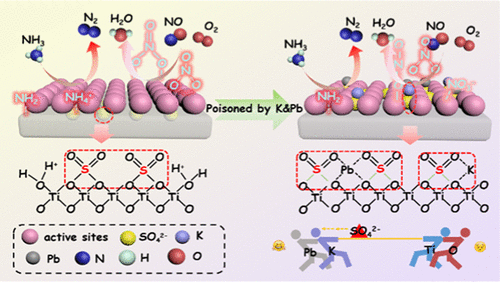当前位置:
X-MOL 学术
›
Environ. Sci. Technol.
›
论文详情
Our official English website, www.x-mol.net, welcomes your
feedback! (Note: you will need to create a separate account there.)
Self-Protected CeO2-SnO2@SO42-/TiO2 Catalysts with Extraordinary Resistance to Alkali and Heavy Metals for NOx Reduction.
Environmental Science & Technology ( IF 10.8 ) Pub Date : 2020-09-02 , DOI: 10.1021/acs.est.0c04911 Sixiang Cai 1, 2 , Tuoyu Xu 1, 2 , Penglu Wang 1 , Lupeng Han 1 , Sarawoot Impeng 3 , Yue Li 2 , Tingting Yan 1 , Guorong Chen 1 , Liyi Shi 1 , Dengsong Zhang 1
Environmental Science & Technology ( IF 10.8 ) Pub Date : 2020-09-02 , DOI: 10.1021/acs.est.0c04911 Sixiang Cai 1, 2 , Tuoyu Xu 1, 2 , Penglu Wang 1 , Lupeng Han 1 , Sarawoot Impeng 3 , Yue Li 2 , Tingting Yan 1 , Guorong Chen 1 , Liyi Shi 1 , Dengsong Zhang 1
Affiliation

|
Reducing the poisoning effect of alkali and heavy metals over ammonia selective catalytic reduction (NH3-SCR) catalysts is still an intractable issue, as the presence of K and Pb in fly ash greatly hampers their catalytic activity by impairing the acidity and affecting the redox properties of the catalysts, leading to the reduction in the lifetime of SCR catalysts. To address this issue, we propose a novel self-protected antipoisoning mechanism by designing SO42–/TiO2 superacid supported CeO2–SnO2 catalysts. Owing to the synergistic effect between CeO2 and SnO2 and the strong acidity originating from the SO42–/TiO2 superacid, the catalysts show superior catalytic activity over a wide temperature range (240–510 °C). Moreover, when K or/and Pb are deposited on SO42–/TiO2 catalysts, the bond effect between SO42– and Ti–O would be broken so that the sulfate in the bulk of SO42–/TiO2 superacid support would be induced to migrate to the surface to bond with K and Pb, thus prohibiting poisons from attacking the Ce–Sn active sites, and significantly boosting the resistance. Hopefully, this novel self-protection mechanism derived from the migration of sulfate in the SO42–/TiO2 superacid to resist alkali and heavy metals provides a new avenue for designing novel catalysts with outstanding resistance to alkali and heavy metals.
中文翻译:

自保护CeO2-SnO2 @ SO42- / TiO2催化剂,对碱和重金属具有极强的抗还原NOx的能力。
通过氨选择性催化还原(NH 3 -SCR)催化剂来减少碱金属和重金属的中毒作用仍然是一个棘手的问题,因为粉煤灰中K和Pb的存在会通过削弱酸度并影响氧化还原来极大地阻碍其催化活性。催化剂的性质,导致SCR催化剂寿命的减少。为了解决这个问题,我们通过设计SO 4 2- / TiO 2超强酸负载的CeO 2 -SnO 2催化剂,提出了一种新型的自保护抗毒机理。由于CeO 2和SnO 2之间的协同作用以及源自SO 4 2–的强酸性/ TiO 2超强酸,该催化剂在较宽的温度范围(240–510°C)中显示出优异的催化活性。此外,当K或/和Pb沉积在SO 4 2- / TiO 2催化剂上时,SO 4 2-和Ti-O之间的键合作用将被破坏,从而使大部分SO 4 2- / TiO 2中的硫酸盐超酸支持物将被诱导迁移到表面以与K和Pb结合,从而阻止了毒物攻击Ce-Sn活性位点,并显着增强了抗性。希望这种新颖的自我保护机制源自硫酸盐在SO 4 2- / TiO 2中的迁移。 耐碱和重金属的超强酸为设计具有出色的耐碱和重金属性能的新型催化剂提供了新途径。
更新日期:2020-09-02
中文翻译:

自保护CeO2-SnO2 @ SO42- / TiO2催化剂,对碱和重金属具有极强的抗还原NOx的能力。
通过氨选择性催化还原(NH 3 -SCR)催化剂来减少碱金属和重金属的中毒作用仍然是一个棘手的问题,因为粉煤灰中K和Pb的存在会通过削弱酸度并影响氧化还原来极大地阻碍其催化活性。催化剂的性质,导致SCR催化剂寿命的减少。为了解决这个问题,我们通过设计SO 4 2- / TiO 2超强酸负载的CeO 2 -SnO 2催化剂,提出了一种新型的自保护抗毒机理。由于CeO 2和SnO 2之间的协同作用以及源自SO 4 2–的强酸性/ TiO 2超强酸,该催化剂在较宽的温度范围(240–510°C)中显示出优异的催化活性。此外,当K或/和Pb沉积在SO 4 2- / TiO 2催化剂上时,SO 4 2-和Ti-O之间的键合作用将被破坏,从而使大部分SO 4 2- / TiO 2中的硫酸盐超酸支持物将被诱导迁移到表面以与K和Pb结合,从而阻止了毒物攻击Ce-Sn活性位点,并显着增强了抗性。希望这种新颖的自我保护机制源自硫酸盐在SO 4 2- / TiO 2中的迁移。 耐碱和重金属的超强酸为设计具有出色的耐碱和重金属性能的新型催化剂提供了新途径。











































 京公网安备 11010802027423号
京公网安备 11010802027423号